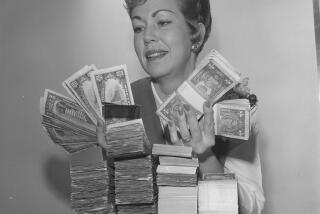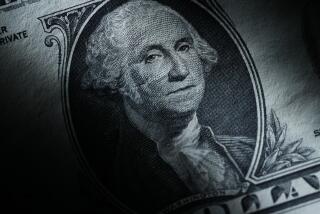It’s Back, It’s Improved: Banking by Computer
- Share via
Home banking, a once-touted service that nearly died of neglect, is being revived with better products and greater consumer receptivity to new technologies. The result: Millions of Americans probably will be banking via personal computer within the decade.
The newest entries in the home banking market are two of the nation’s biggest sellers of personal finance software--Microsoft and Intuit. Both companies have formed alliances with banks and credit card companies to offer a wide array of check-paying and bank information services via computer.
Several regional phone companies also are working with banks to offer bank services by “video phone,” and other companies promise to usher in home banking with interactive television.
These companies are trying to learn from the mistakes of others. Banks began to roll out products for personal computer banking more than a decade ago, but few of the products ever caught on. And when Chemical Bank--which had offered Pronto, one of the most comprehensive early home banking products--dropped out of the market in the mid 1980s, the industry was thought to be far from success. Home banking products had captured between 1% and 2% of the banking market over the previous 10 years.
Some computer users already bank from home. Intuit’s Quicken software, for example, works with a service called CheckFree, which charges $9.95 monthly for the first 20 electronic checks written each month. Prodigy, an on-line service, also has a home banking product that it offers in conjunction with certain banks.
The bank-based products, however, were frequently ponderous and ignored many of the bells and whistles available with financial software. The software companies, meanwhile, couldn’t offer interactive access to your own bank--to transfer money between accounts, for example, or to log on to see if a check had cleared.
That seems primed for change, thanks to a flurry of joint ventures formed between banks and computer companies in the last year:
* A subsidiary of regional phone company US West announced last summer that it will team up with Electronic Data Systems and a French company to develop home banking by interactive television.
* A host of banks--from Citibank in New York to Banc One Corp. in Columbus, Ohio--have announced plans to test market telephone-based home banking systems.
* Intuit, of Menlo Park, announced it would team up with Visa to offer home banking via personal computer to any Visa-member bank that wants to sign on.
* And, late last year, Microsoft announced it would join with a handful of banks to offer home banking products in conjunction with its popular Money software.
These and other companies are optimistic because vast improvements in technology are making home banking products cheaper, friendlier and more comprehensive. Also, today’s consumer is more technologically literate and willing to buy and use the sophisticated systems that are necessary for full-scale home banking.
“The market just wasn’t ready for home banking when it was first offered,” says Richard Bray, product manager at Microsoft in Redmond, Wash. “There weren’t that many people with personal computers, and the technology was evolving too fast for the banks to keep up. It wasn’t long before the bank products began to look obsolete, in terms of what a personal computer could do.”
Now, 20 million to 30 million Americans have home computers, he says. More and more home computers have modems, which let computers talk to one another by phone, and many of these computers are newer models with the power necessary to run easy-to-use, graphically oriented personal-finance software.
*
About 52% of Americans now are willing to bank and pay bills by phone, and roughly 15% would use a personal computer for banking if their bank offered the service, said Neal Chambliss, vice president of PSI, a Tampa-based research firm that conducts home banking surveys.
Already, consumers are banking via “remote” more than half the time, adds Nik Banerjee, director of retail banking for the Bank Administration Institute, a Chicago-based trade group. About 31% of bank transactions are done at automated teller machines, while 24% are done over the phone, Banerjee says. Another 2% use “other” means--primarily personal computers.
Just 43% of all transactions are done in bank branches, according to BAI statistics.
But what may prove to be the pivotal measures of whether home banking will fly now are the products themselves. There’s no doubt that what’s being offered today is a far cry from what was on the market a decade ago.
Consider Microsoft’s soon-to-be-introduced program: Money software to go on the market next month will be able to hook your computer into three new services--Bank On-Line, Pay On-Line and Quotes On-Line (for updating stock and mutual fund portfolios).
Many banks are expected to offer Bank On-Line and Pay On-Line together as a package deal for about $15 a month. With them, you would be able to transfer money between linked accounts, find out current balances and pay bills.
You also will be able to copy the bank’s records of your accounts into your personal computer. Meanwhile, some of the television and telephone-based home banking products promise to link you to shopping networks and investment services as well. You could see something you like on the shopping channel, flip to the banking channel to check your balance, then press a few buttons to buy the item. Or you could transfer cash from your checking account to your mutual fund without bothering to budge from the couch.
“When these products were solely for banking, they really didn’t make sense for the price,” said Chuck Bruney, senior vice president at Speer & Associates in Atlanta. “But now that third-party vendors (computer and phone companies) are packaging them with other products, I really believe they’re going to catch on.”
Home Bank Tips What should you look for in a home banking product? Here are some key factors:
* Cost. Even though the cost of most home banking products has come down, they still are relatively expensive. Typically, you’ll pay between $10 and $15 a month for a product that allows you unlimited access to balance information, some checking account statements and the ability to pay 20 bills per month via remote. The bill-paying feature, if used to capacity and no further, saves you roughly $6 a month in stamps and envelopes. So the net cost is between $4 and $9, in addition to your ordinary checking account fees.
* Compatability. Most products work either in conjunction with a sophisticated telephone or a high-powered computer. If you have to buy equipment that’s compatible with the home banking product, your overall cost soars. Screen phones, for example, cost between $100 and $500 each. Software for the computer-based programs can run $50 to $150, depending on what software you’ve already got. And if you need to upgrade your computer, add several hundred more dollars to the cost. Some companies will lend or rent necessary equipment. If your bank won’t, consider products that work with what you’ve got.
* Transferability. Do you like your bank enough to know that you won’t be switching in the near future? If not, make sure your home banking service is offered by other banks before you spend money on software or equipment that can’t be used anywhere else.
* Feel. Only you can determine whether you like the way a particular product feels. Is is ponderous? Does it require too much typing or technological skill? The only way to find out is to try it out. Ask your bank if you can have a free trial period to see if you like it.
More to Read
Inside the business of entertainment
The Wide Shot brings you news, analysis and insights on everything from streaming wars to production — and what it all means for the future.
You may occasionally receive promotional content from the Los Angeles Times.








